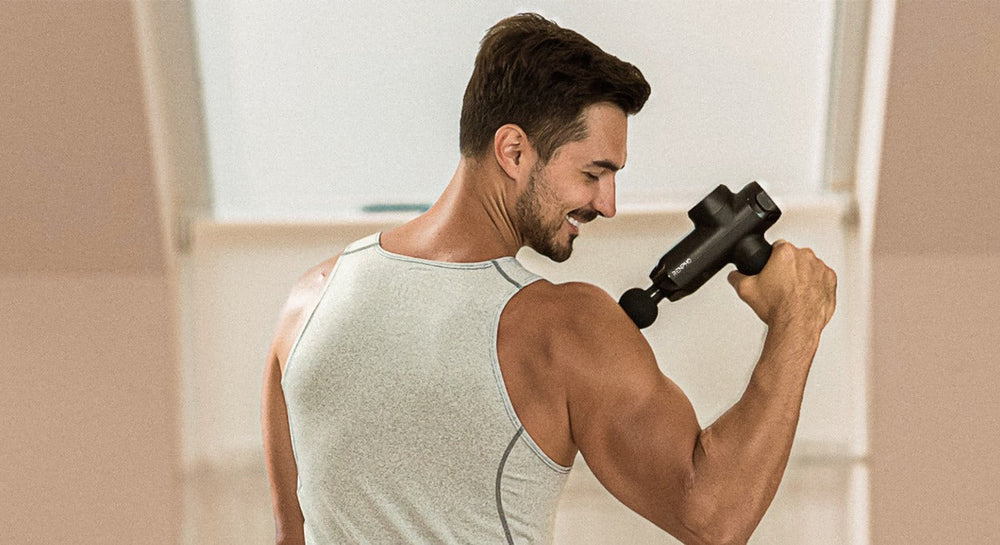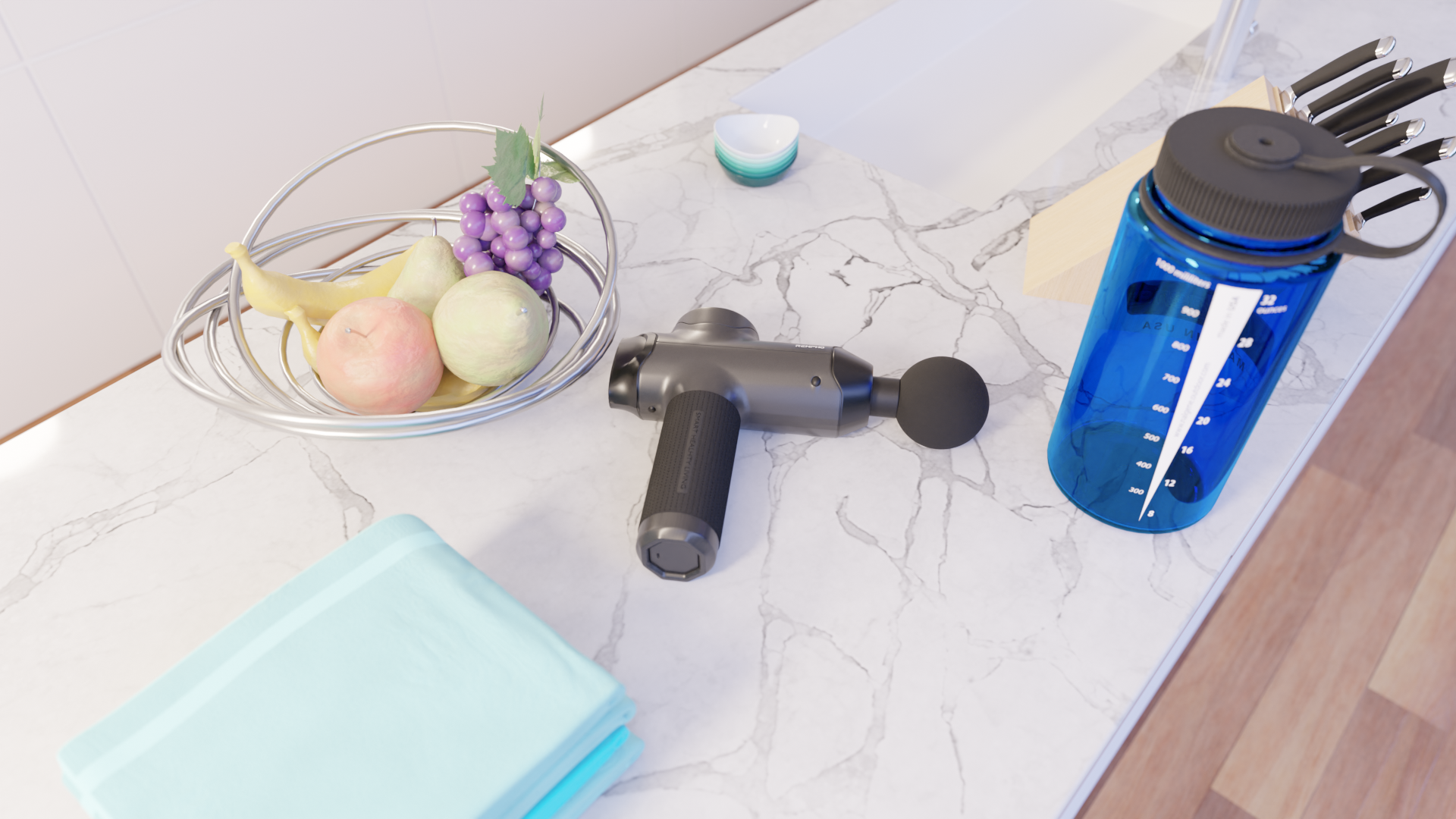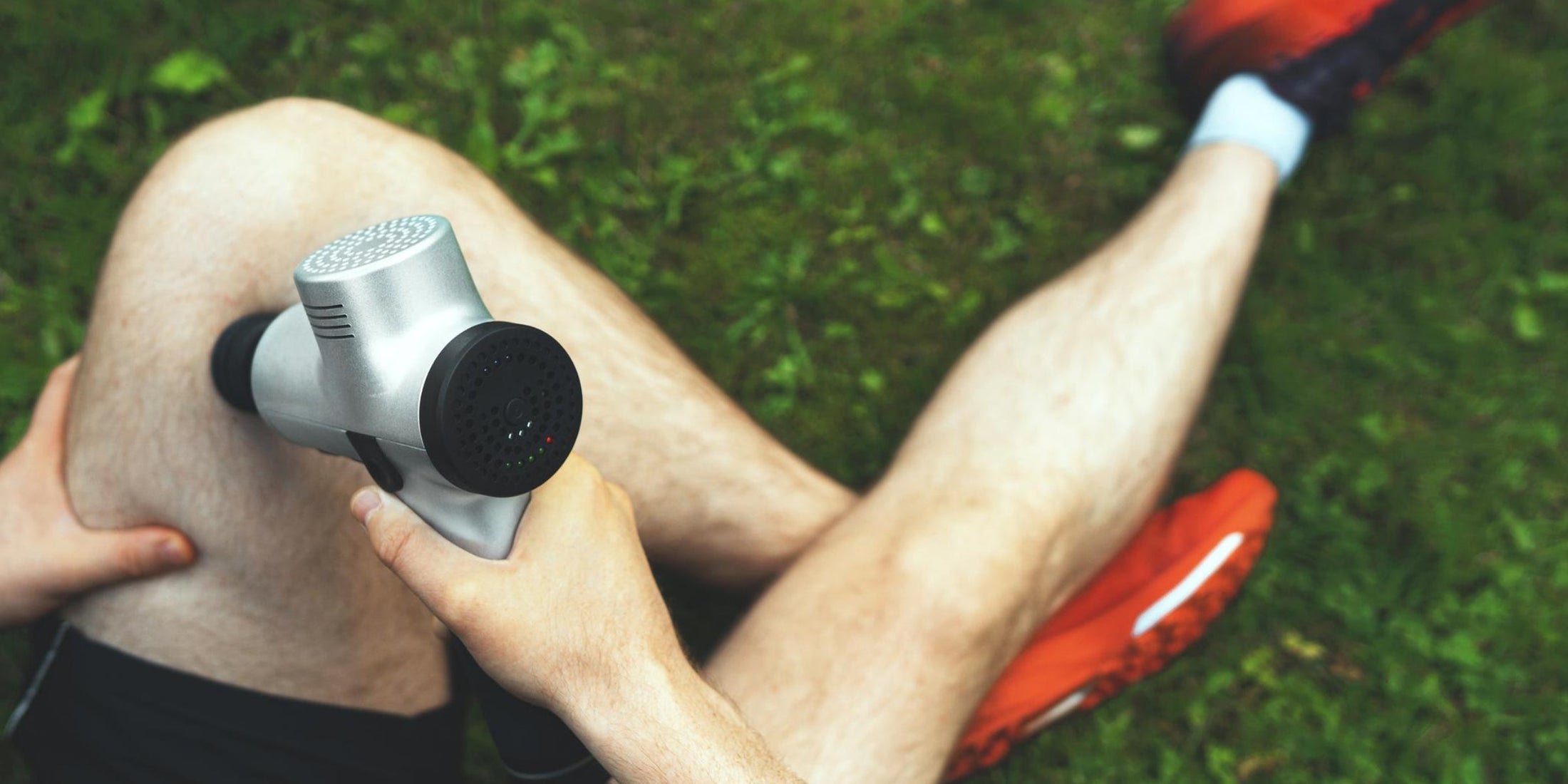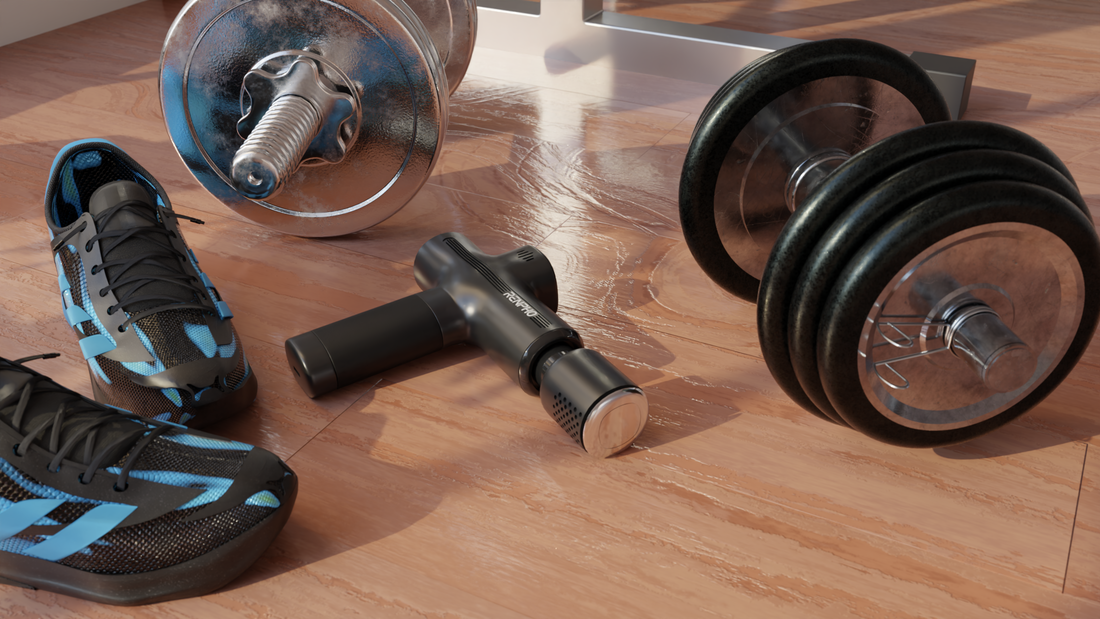Do Massage Guns Work? Benefits, Features, and Facts

Stay tuned to our latest news
Massage guns are handheld devices powered by motors to deliver rapid bursts of pressure into muscle tissue.
But do massage guns work? While they are widely used to reduce muscle soreness after workouts, many athletes, fitness enthusiasts, or anyone looking to relieve muscle tension still ask this question. How is the rapid and repetitive pressure helpful for muscle recovery?
In this article, you will learn more about how massage guns work, the numerous benefits they offer, their special features, and what you need to consider before investing in them.
What are Massage Guns and Percussive Therapy
At its core, a massage gun mimics a deep tissue massage. This form of massage, typically performed by a massage therapist, targets the deeper layers of muscle using slow, long strokes with focused pressure. It is particularly helpful in relieving chronic tension in muscles.
On the other hand, massage guns harness the power of percussive therapy through a combination of rapid, repetitive pressure and vibration. With a massage gun, you can achieve similar results on your own, free from the hassle of scheduling massage appointments. This innovative device allows you to target muscle tension anytime and anywhere, making it a convenient and effective alternative for alleviating discomfort.
How Do Massage Guns Work
Massage guns, also known as percussion massagers, are those handy little devices that have taken the fitness and wellness world by storm. But why? How can this small device make such a big difference? Let me break down how the massage gun works its magic.
When you press the massage gun against your body, the percussive action helps to loosen up tight muscles, improve blood flow, and release tension. Additionally, the vibrations also stimulate nerve endings. It's like having a personal massage therapist available at all times! It doesn’t just help you relax your muscles —studies suggest this can help reduce overall pain and discomfort.
When Not to Use a Massage Gun
Massage guns are fantastic tools for relieving muscle tension and soreness, but they’re not always the right choice for every ache, pain, or situation. So, let’s talk about when you should hit pause on that massage gun session.
1. Over Bones or Joints
Massage guns are designed to work on muscles—not bones or joints. If you’re using it around bony areas like your shins, knees, or elbows, you might feel more discomfort than relief. Plus, the muscle in that area is thin. It may be okay if you've got quite a lot of muscle covering that area, like your bum, for instance. If you are ever unsure of the area, it may be better to avoid massage guns, and it’s not really effective in doing much for you in those spots anyway.
2. If You Have Certain Medical Conditions
If you have issues like blood clotting disorders, deep vein thrombosis (DVT), or certain heart conditions, such as strokes, using a massage gun could be risky. These devices increase blood flow and pressure in the area, which might not be ideal depending on your condition. Always check with a doctor if you’re unsure.
3. Directly on Inflammation or Swollen Areas
Inflammation and swelling are signs that your body is healing. While a massage gun can help muscles recover from small-scale damage, using it on an injured area can actually make things worse by increasing inflammation or causing further damage that slows down the healing process. Let your body heal itself before introducing any extra stimulation.
4. Recent Muscle, Tendon, or Ligament Tear
When dealing with a tear in the muscles, tendons, or ligaments, proper healing is essential to allow these tissues to repair and grow back together properly. While massage guns are great for relieving post-workout muscle soreness, they are not a one-size-fits-all solution to any pain you might have. In fact, using a massage gun on an injured area can disrupt the healing process causing more damage. It is important to explore alternative ways to manage the pain without risking further issues!
5. When You’re Too Sore
We’ve all been there—DOMS (delayed onset muscle soreness) hits hard after an intense workout, and all you want is relief. Massage guns can be used to ease DOMS, but if the pain is too intense, then consider putting a pause on using the massage gun as it may be too aggressive. Instead, try gentler methods like foam rolling or stretching until the soreness subsides a bit.
6. If You’re Not Sure How to Use It Properly
Massage guns are powerful tools, and using them incorrectly can do more harm than good. If you’re pressing too hard, using the wrong attachment, or holding it on one spot for too long, you could end up with bruising or irritation. Take some time to learn how to use it properly before diving straight in.
7. On Open Wounds, Rashes or New Scars
This one might seem obvious, but it’s worth mentioning—don’t use a massage gun on open wounds, cuts, rashes, blisters, or any other skin conditions. It’s not only painful but could also lead to infection or further irritation.
If you’ve got a new scar, younger than 12 weeks, using vibrations on it could prolong healing leading to excessive scar tissue or even damage the scar itself. So, if you’ve had significant surgery, be sure to check with your surgeon or doctor to see if it’s okay to use a massage gun on that area!
8. Avoiding the Face and Head with Massage Guns
It’s really important to steer clear of using massage guns on your face and head. Here’s why:
Eye Safety:
The vibrations from a massage gun can possibly harm your eyes. Research shows excessive vibration can loosen the retina, which can lead to serious vision problems.
Ear Damage:
The vibrations can also harm your ears. Since the ear structure is delicate, using a massage gun near this area could result in damage to the inner ear, affecting your hearing.
Lack of Muscle Padding:
Unlike other parts of your body, the face and head don’t have a lot of muscle to help with absorbing impact force. This means there’s a higher risk of injury from direct impact, like head trauma and blood clots caused by using massage guns.
Vascular Concerns:
The head and neck area are rich in arteries and veins. Using a massage gun here could inadvertently damage these blood vessels, leading to bruising or more serious complications.
Do Massage Guns Really Work?
When it comes to muscle recovery and pain relief, massage guns have surged in popularity, prompting the question: Do they really work? The answer is a resounding yes.
Renato Sanchez, PT, DPT, C.S.C.S., a physical therapist from Bespoke Treatments San Diego, has done extensive research to show massage guns can increase mobility, decrease pain and soreness, and improve overall performance. It won’t be the fix-all tool to dramatically improve your health, but it will be a valuable supplement to your routine.
Massage guns operate by delivering rapid bursts of pressure to the muscle tissue through percussive therapy. This process can help improve blood circulation, reduce muscle soreness, and enhance flexibility. Many users report feeling immediate relief from tension and an increase in range of motion after just a few minutes of use.
However, not only do massage guns provide the much-needed deep percussion therapy, but they also make performing it easier than before. Massage guns are portable and user-friendly, making them a convenient option for athletes or anyone looking to relieve muscle tightness at home or on the go. Percussion massagers are great for warming up your muscles before you dive into an activity or for helping you cool down afterward," says Gary Calabrese, a physical therapist at the Cleveland Clinic.
When used correctly, massage guns can be a valuable tool in your wellness arsenal.
FAQs About Massage Guns
While massage guns become increasingly popular for relieving muscle tension and enhancing recovery, many still have questions about their safety and maintenance, as well as how to use them properly. Below we put together a list of frequently asked questions about massage guns.
1. Are Massage Guns Safe to Use?
Absolutely! When used properly, massage guns are safe tools. However, it's super important to know how to use them and which areas to target—or avoid—before you buy one. Certain spots can be sensitive to the pressure from a massage gun. Plus, if you have any medical conditions or injuries, it’s a good idea to check with a healthcare professional before using one.
2. How Do I Choose the Right Speed and Attachment?
Most massage guns come with attachments designed for different muscle groups. Depending on the area where you experience muscle soreness or stiffness, use specific attachments, ask professionals, or the product specialist who has knowledge about the settings and the device.
3. How Often Should I Use my Massage Gun?
Some people only use massage guns to warm up muscles to increase blood flow before a workout. Others use them after a workout to recover. Frequency depends on individual needs, but generally 2-3 times per week is effective for most people. When using it, leave at least 48 hours between treatments as after a massage gun session, your body needs time to heal.
4. What’s the Best Massage Gun to Get?
The best massage gun for you will really depend on your personal needs and preferences. Be sure to think about things like motor strength, the number of speed settings, and what types of attachments come with it.
In the next section, we’ll walk you through how to choose the best massage gun for you.
How to Choose the Right Massage Gun
Choosing the right massage gun can significantly enhance your recovery and wellness routine, but with so many options on the market, it’s crucial to make an informed decision. Here’s a guide to help you select the best massage gun based on key factors.
Consider your personal needs:
If you're an athlete focused on recovery after intense training sessions, opt for a model with reliable battery power and multiple attachments, like the RENPHO POWER Massage Gun, which has up to level 6 power and is compatible with people who work out regularly.
For general wellness enthusiasts looking to relieve tension after long days at work, a mid-range option, a MINI Massage Gun will do it for you. It is compact with a sleek design, trendy colors and essential features. Another alternative is the RENPHO REACH Massage Gun which is more convenient for you to use while targeting areas harder to reach.
Price:
Start by determining your budget. Massage guns can range from affordable models under $100 to high-end versions exceeding $500. If you’re looking for a budget-friendly and quality massage gun, check the RENPHO website, which has a better deal than others when it comes to massage guns.
Features:
Look for essential features such as adjustable speed settings, battery life, and noise level. A massage gun with multiple speed settings allows you to customize your experience based on your needs—whether you want a gentle massage or a deep tissue experience.
Attachments:
Different attachments serve various purposes; some are designed to target specific muscle groups while others provide broader coverage. For athletes or individuals frequently engaging in strenuous activities, having multiple attachment heads can enhance versatility and effectiveness.
By weighing factors of — needs, price, features, and attachments—you can confidently select a massage gun that meets your preference. Whether you're an athlete striving to enhance your performance or someone seeking relaxation, a massage gun puts convenience and comfort into the palm of your hand.
Renpho Health Tips
-

The Benefits of Percussion Therapy for Your Body and Mind
August 2, 2024
Read more >
-

Achieving Recovery: Are Massage Guns the Ultimate Post-Workout Tool?
September 5, 2024
Read more >
-

The Ultimate Therapy Gun Maintenance Checklist: Steps to Ensure Peak Performance
May 13, 2024
Read more >
-

Pocket-Sized Power: Discovering the Advantages of Mini Massage Guns for Runners
August 6, 2024
Read more >
-

Revitalize Your Body: How a Percussion Massage Gun Can Transform Your Fitness Routine
September 4, 2024
Read more >





